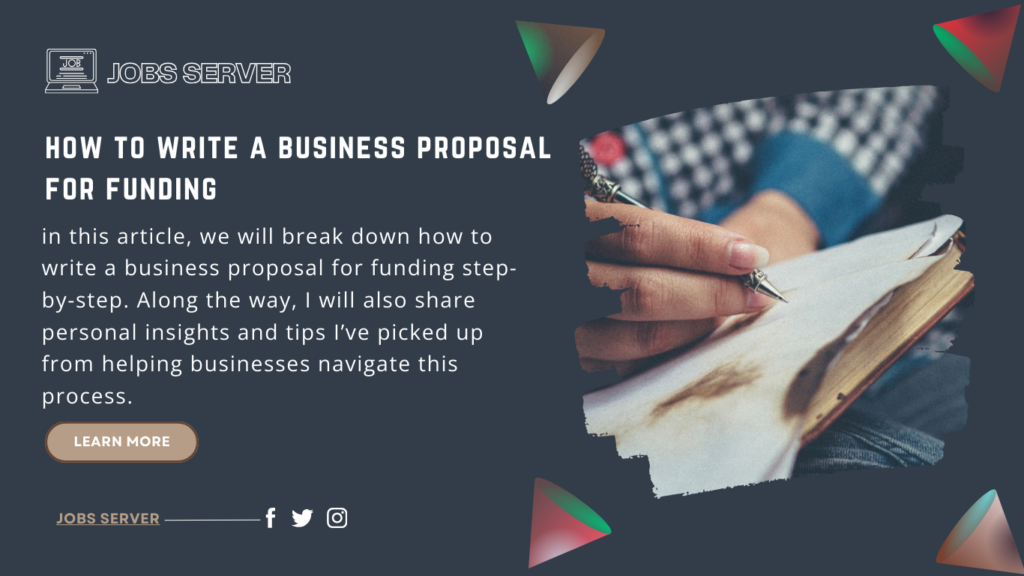HOW TO WRITE A BUSINESS PROPOSAL FOR FUNDING
INTRODUCTION
A business proposal for funding is a formal document that outlines a company’s or personal need for financial support and explains how the funds will be used to grow a personal business or company business. It is typically prepared to persuade investors, lenders, or grant providers to provide financial backing. The proposal presents a detailed picture of the business, including its goals, market opportunity, revenue model, and financial projections.
In Nature, A Funding Proposal Demonstrates:
- What the business does
- Why funding is needed
- How the funding will be used
- How the investment or loan will benefit the funder
However, writing a business proposal for funding can feel like a handful jobs, but it’s one of the most critical steps in securing financial support for your business. Whether you are a startup founder looking for seed capital or an established entrepreneur seeking expansion funding, creating a compelling, well-structured proposal is essential. A good business proposal communicates your vision, your business’s potential, and how the funding will be used to drive growth and returns.
In this article, we will break down how to write a business proposal for funding step-by-step. Along the way, I will also share personal insights and tips I’ve picked up from helping businesses navigate this process.
Let’s begin!
- ALSO CHECK
- Step By Step On How To Write An Argumentative Essay
- Step By Step On How to Write A Curriculum Vitae for A Job
- Step By Step On How To Write Good Undertaking Letter To A Principal
- Step By Step On How To Write Good Acknowledgment For A Project?
IMPORTANT OF A BUSINESS PROPOSAL FOR FUNDING
When you’re seeking funding, whether from investors, banks, or grants, your proposal is your first impression. It’s more than just a document, it’s your opportunity to explain why someone should invest in your business.
When I wrote my first business proposal, I learned quickly that it wasn’t just about having a great idea. I had to convince others that my idea was financially sound and had growth potential. In hindsight, I see now that every part of the proposal was about storytelling: telling the story of my business’s future, its needs, and its expected success.
A Well-Written Business Proposal Shows:
- Your Clarity Of Purpose: Many Investors want to see that you have a well-thought-out business plan.
- Your Understanding Of Financials: Funding is always tied to money, and how you plan to use it matters.
- Your Credibility: The proposal reflects your professionalism and your ability to deliver on your promises.
STEP-BY-STEP ON HOW TO WRITE A BUSINESS PROPOSAL FOR FUNDING
Let’s break down the process into manageable steps. This step will help you navigate each critical section of your proposal while ensuring you cover all the key elements needed to secure funding.
1. You Should Start With An Decision-making Summary
The executive summary is the first thing the potential funder will see. It should be concise and to the point, providing a high-level overview of your business and the purpose of the proposal. Think of it as your elevator pitch.
In my experience, many entrepreneurs struggle with this section, trying to include too many details. Remember, less is required in this aspect. Focus on the main points:
- What your business does
- The market opportunity
- The funding you need
- How the funding will be used
- What returns the funder can expect (if applicable)
When I wrote the executive summary for my second startup, I highlighted our disruptive technology, the market gap we aimed to fill, and our projected revenue in the next two years. This quick snapshot helped investors understand the potential right away.
2. Input And Describe Your Company Overview
In this section, describe your business in detail. Talk about your business’s history, structure, mission, vision, and core values. If you have a unique value proposition, highlight that here.
Investors and lenders want to know that they’re putting their money into a company with a solid foundation. Here’s where you showcase your leadership team, their qualifications, and why your business is well-positioned to succeed.
3. State The Business Problem And Solution
Every business exists to solve a problem. Clearly define the problem that your business addresses. After explaining the problem, follow up with how your business offers a solution.
When I pitched my e-commerce startup, I was very specific about the pain points my target market experienced. By clearly defining the problem and showing how my product solved it, I made it easier for investors to see the value of my business.
- Problem: Identify the challenge in the market.
- Solution: Explain how your product or service provides an innovative and effective solution.
4. Make Use Of Market Analysis
Market analysis is a key section that shows you’ve done your homework. Here, you’ll demonstrate your knowledge of the industry, the competition, and your target audience. This section requires data-driven insights.
Step To Make This Section Stand Out:
- Use market research to back up your claims.
- Show trends and growth opportunities in your industry.
- Provide a competitor analysis—how does your product/service differentiate?
Make use of SWOT analysis, because when I wrote this section for my latest proposal, I included a SWOT analysis (Strengths, Weaknesses, Opportunities, and Threats). This not only made my market understanding clearer but also demonstrated that I had thought about the challenges and opportunities.
6. State Your Business Prototype
When I approached investors for my online subscription service, I explained how our recurring revenue model worked, including our customer acquisition costs and lifetime value. The clearer you are here, the better your chances of convincing investors that your business is sustainable.
So, Your business model should outline how your company makes money. Investors will want to know how you plan to generate revenue and maintain profitability.
This Section Must Include:
- Your revenue streams
- Pricing strategy
- Sales and marketing strategy
6. Explain Your Operational And Management Plan
Next, explain how your business operates on a day-to-day basis. Investors like to see that you’ve thought through the logistics of running your business.
In This Section, You Should Put:
- Your operational processes
- Your supply chain (if applicable)
- Key roles in your team
- Any external partners or suppliers
Make sure to demonstrate that your team has the right experience and skills to execute the business plan. If your business relies on outside partnerships or suppliers, explain how these relationships will be maintained.
7. State Your Marketing And Sales Strategy
Here is where you lay out how you plan to attract and retain customers. An effective marketing strategy is important for growth, and funders want to know how you plan to make your business visible in the marketplace.
Consider Implementing These Essentials:
- Your target audience
- Marketing channels (e.g., social media, email marketing, SEO)
- Sales process (how you convert leads into customers)
- Customer retention strategy
In my business proposal for a wellness brand, I emphasized the power of niche marketing. By identifying a specific target audience, I was able to demonstrate that our marketing efforts would be cost-effective and high-impact.
8. State Your Financial Plan And Projections
This is one of the most critical sections in your business proposal for funding. Investors want to see that your business is financially sound and has growth potential.
Detailed Financial Statements Must Include:
- Revenue projections
- Profit and loss statements
- Cash flow analysis
- Break-even analysis
It’s important to be realistic here. Inflating numbers or making overly optimistic predictions will undermine your credibility. In one of my early proposals, I learned the hard way that being too ambitious with financial projections can backfire. Instead, offer a realistic path to profitability based on conservative assumptions.
9. State Your Funding Requirements
Now, it’s time to specify how much funding you need and how you will use it. Be clear about the total amount you’re seeking and break down exactly how you’ll allocate the funds. Whether it’s for hiring, marketing, product development, or operational expenses, funders want to know that their money will be used effectively.
For one of my startups, I outlined a 12-month budget, specifying how much would go toward marketing, new hires, and technology upgrades. This level of transparency helped me secure the funding I needed.
10. Exit Strategy (for Investors)
If you’re seeking funding from investors, they’ll want to know how and when they’ll get a return on their investment. This section should include a plan for how investors can exit with a profit, whether it’s through a sale, IPO, or buyout.
Even if you’re not thinking about an exit yet, investors will be, so it’s important to include a roadmap. In my experience, having an exit strategy adds credibility and shows that you’re thinking long-term.

ADVANTAGES OF WRITING A GOOD BUSINESS PROPOSAL FOR FUNDING
- It Will Increases Your Chances Of Securing Funds: A well-structured proposal is essential for convincing investors or lenders to give you money.
- It Helps In Clarifying Your Business Plan: The process of writing a proposal forces you to clarify your business goals and strategies.
- It Helps In Building Investor Confidence: A strong proposal demonstrates that you have thought through the details of how you’ll use the funding effectively.
- It Sets A Solid Growth Path For You: The financial planning involved in the proposal helps you create a roadmap for future growth.
DISADVANTAGES OF NOT WRITING A GOOD BUSINESS PROPOSAL FOR FUNDING
- Writing a detailed business proposal can be a lengthy process, requiring a lot of research and preparation.
- If you lack financial or business experience, writing a compelling proposal may require outside help, which can be costly.
- Even with a solid proposal, there’s no guarantee of success. It can be discouraging to put in the effort and not secure the funding.
- Some proposals become so detailed that they overwhelm the reader. Striking the balance between comprehensive and concise is a challenge.
My Final Thoughts On Writing A Business Proposal For Funding
The process of writing a business proposal for funding is a test of both your vision and your planning skills. You need to show potential investors that you understand your market, have a clear strategy, and have thought through every aspect of your business.
Remember, a successful proposal is not just about asking for money, it’s about building trust with your investors. By following these steps and putting the time and effort into writing a thoughtful, detailed proposal, you’ll greatly improve your chances of securing the funding you need to grow your business.
Whether you’re just starting or looking to scale, writing a business proposal is an essential skill for any entrepreneur.
SOME ASKED QUESTIONS AND ANSWERS ABOUT HOW TO WRITE A BUSINESS PROPOSAL FOR FUNDING
- What should be included in a business proposal for funding?
A solid business proposal for funding should include an executive summary, company overview, market analysis, problem and solution statement, business model, financial projections, and funding requirements. Each section must clearly outline why your business deserves funding and how it will generate returns.
- How do I convince investors to fund my business?
Investors want to see a strong business plan, clear financial projections, and a well-defined growth strategy. Highlight how your product or service solves a real problem, demonstrate market demand, and explain how their investment will lead to profit.
- How long should a funding proposal be?
While there’s no strict rule, most business proposals range from 10 to 20 pages. The key is to be thorough without overwhelming the reader. Include all essential information, but focus on clarity and conciseness.
- What financial documents should I include in a business proposal?
Your proposal should include profit and loss statements, cash flow forecasts, balance sheets, and revenue projections. Investors need to understand your current financial position and how funding will drive future growth.
- How can I make my business proposal stand out?
Personalize your proposal for each potential funder. Research their investment focus and tailor your pitch to align with their goals. Use compelling data, present a clear path to success, and demonstrate your industry expertise.
- Do I need to include an exit strategy in a business proposal?
Yes, especially if you’re pitching to investors. An exit strategy outlines how they’ll get their return, whether through acquisition, IPO, or buyout. It shows you’re thinking long-term and care about their success too.
- How do I write a convincing executive summary for funding?
Keep your executive summary concise, clear, and compelling. Highlight your business’s core mission, market potential, funding needs, and how the investment will be used. The goal is to grab attention and encourage the reader to dive deeper into your proposal.
- Can I reuse a business proposal for different investors?
While you can reuse parts of your proposal, it’s crucial to customize each one. Different investors have unique interests, so tweak your proposal to match their specific needs, goals, and industry focus.
- What common mistakes should I avoid in a business proposal?
Avoid vague financial projections, lack of market research, overpromising, and poor organization. Be realistic, back up your claims with data, and present a clear, professional document
- How important is market research in a business proposal?
Market research is critical. It shows investors that you understand your industry, your competitors, and your target audience. Solid market analysis builds confidence in your business’s potential for success.
- What are the key elements of a funding request in a business proposal?
Your funding request should be clear and specific. State the exact amount you need, how the funds will be used, and what milestones will be achieved with the investment. Transparency builds trust.
- How can I prove my business is a good investment?
Prove your business is a good investment by providing detailed financials, demonstrating a large market opportunity, and showcasing strong leadership. Explain how the investment will lead to growth and returns.
- Is it necessary to include a competitor analysis in a funding proposal?
Yes, a competitor analysis is vital. Investors want to know how you’ll stand out in the market. Identify your competitors, their strengths, and weaknesses, and explain how your business offers a better solution.
- How do I present realistic financial projections in my proposal?
Your projections should be based on thorough market research, current performance, and reasonable growth expectations. Avoid overly optimistic numbers; investors prefer conservative, well-thought-out estimates.
- What tone should I use in a business proposal for funding?
Keep your tone professional but engaging. Be confident without sounding arrogant. You want to show you’re serious about your business and open to collaboration and feedback.





